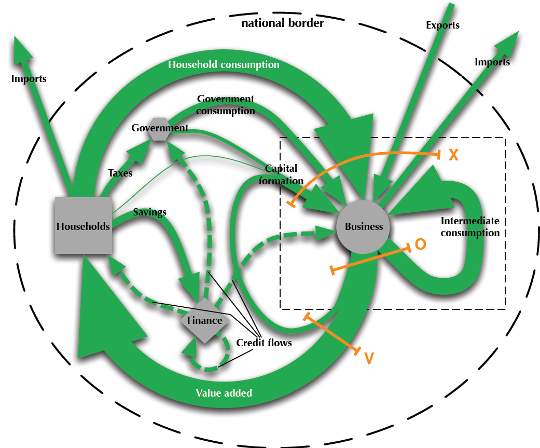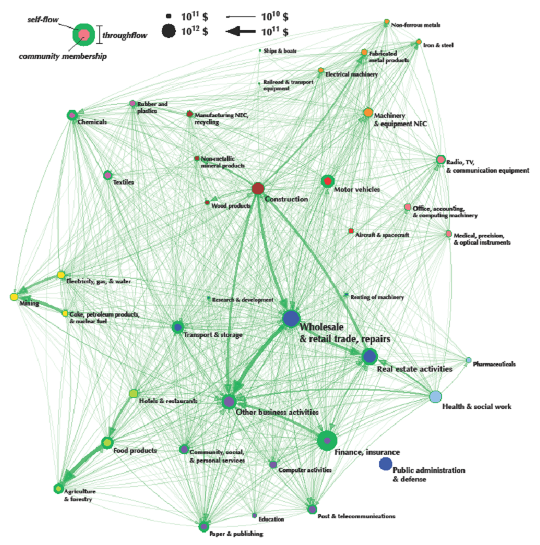Structure and robustness of economic networks
The regional, national, and global economies can be represented as a directed network in which nodes are economic agents (separate economic sectors or whole countries) and links are the financial flows between them.
Globalization leads to ever-growing size, flows, and interconnectivity in modern economic networks with more and more people, companies, and nations becoming connected in a complex way.
The recent economic crisis poses the question of the vulnerability of economic networks. Intuitively it seems to be clear that networks with a certain structure must be more stable to external shocks than others. However, the debate about what specific features of the network structures make them more resilient is still ongoing in the academic and management worlds. For example, the so-called stability-complexity debate in ecology confronts the issue of whether making a system more complex makes it more resilient or less. Evidence for both has been found in different studies.
ASA has been contributing to the research of network structures and resilience by conducting studies of economic networks (their principal construct is given in Figure 1).

Figure 1. Principal scheme of nodes and flows in economic networks. Source: McNerley et al. [1].

Figure 2: An example of inter-industry network of a national economy. Source: McNerley et al. [1]
Data were studied on inter-industry flows in networks of national economies (see Figure 2 for an example) which are found to vary around a typical structure characterized by a Weibull link weight distribution, exponential industry size distribution, and a common community structure [1].
An ecological information-based approach was examined – a promising holistic measurement which incorporates both efficiency and redundancy dimensions of sustainability – using data on global resource trade flow networks [2]. From the perspective of biomimicry, it appears that these networks can achieve higher levels of efficiency without weakening their robustness to resource delivery.
In the framework of the ASA project “Structural change of the Finnish Economy – a Systems Approach” funded by the Finnish Ministry of Employment and the Economy (2012-2013) economic networks representing intermediate good flows between economic sectors as well as export and import flows for three Finnish regions - Pori, Joensuu and Oulu - were studied. It was found that in all three regions the most effective policy intervention for stimulating local production was to increase state subsidies to the unemployed and state demand. Regional resilience seems to depend on the share of intermediate usage of outputs within the region. A policy report to the Ministry of Employment and the Economy of Finland by Leena Ilmola-Sheppard to be published in 2014 summarizes policy recommendations: two papers presenting the models, results and conclusions are being prepared.
A simple agent-based model (ABM) of bank networks lending to each other was built [3]. It was found that systemic risk of cascading failures can be drastically reduced by increasing transparency, i.e., by making the liability metric of individual banks known to others, and by constraining interbank borrowings from systemically risky nodes. This scheme does not reduce the efficiency of the financial network but fosters a more homogeneous risk-distribution within the system in a self-organized critical way.
References
[1] McNerney J, Fath BD, Silverberg G (2013). Network structure of inter-industry flows. Physica A: Statistical Mechanics and its Applications, 392 (24), 6427—6441.
[2] Kharrazi A, Rovenskaya E, Fath BD, Yarime M, Kraines S (2013). Quantifying the sustainability of economic resource networks: An ecological information-based approach. Ecological Economics, 90, 177—186.
[3] Thurner S, Poledna S (2013). DebtRank-transparency: Controlling systemic risk in financial networks. Scientific Reports 3, Article #1888.
Collaborators
ASA’s main collaborators in the field of structure and robustness of economic networks include J. Geanakoplos, Professor, University of Yale, USA; R. Hausmann, Professor, Harvard University, USA; B.Park, Director, Center for Strategic Foresight, Science and Technology Policy Institute (STEPI), Korea; M. Tykkylainen, Professor, University of Eastern Finland; S. Vahasantanen, Researcher, Turku University.
Research program



